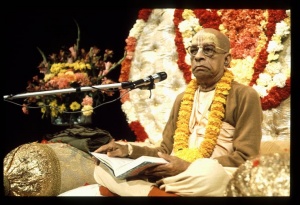CC Adi 10.113 (1975)

A.C. Bhaktivedanta Swami Prabhupada
TEXT 113
- rāmadāsa, kavicandra, śrī-gopāladāsa
- bhāgavatācārya, ṭhākura sāraṅgadāsa
SYNONYMS
rāmadāsa—of the name Rāmadāsa; kavicandra—of the name Kavicandra; śrī gopāla-dāsa—of the name Śrī Gopāla dāsa; bhāgavatācārya—of the name Bhāgavatācārya; ṭhākura sāraṅga-dāsa—of the name Ṭhākura Sāraṅga dāsa.
TRANSLATION
The seventy-third branch of the original tree was Rāmadāsa, the seventy-fourth was Kavicandra, the seventy-fifth was Śrī Gopāla dāsa, the seventy-sixth was Bhāgavatācārya, and the seventy-seventh was Ṭhākura Sāraṅga dāsa.
PURPORT
In the Gaura-gaṇoddeśa-dīpikā (203) it is said, "Bhāgavatācārya compiled a book entitled Kṛṣṇa-prema-taraṅgiṇī, and he was the most beloved devotee of Lord Caitanya Mahāprabhu." When Lord Śrī Caitanya Mahāprabhu visited Varāhanagara, a suburb of Calcutta, He stayed in the house of a most fortunate brāhmaṇa who was a very learned scholar in Bhāgavata literature. As soon as this brāhmaṇa saw Lord Caitanya Mahāprabhu, he began to read Śrīmad-Bhāgavatam. When Mahāprabhu heard his explanation, which expounded bhakti-yoga, He immediately became unconscious in ecstasy. Lord Caitanya later said, "I have never heard such a nice explanation of Śrīmad-Bhāgavatam. I therefore designate you Bhāgavatācārya. Your only duty is to recite Śrīmad-Bhāgavatam. That is My injunction." His real name was Raghunātha. His monastery, which is situated in Varāhanagara, about three and a half miles north of Calcutta on the bank of the Ganges, still exists, and it is managed by the initiated disciples of the late Śrī Rāmadāsa Bābājī. Presently, however, it is not as well managed as in the presence of Bābājī Mahārāja.
Another name of Ṭhākura Śāraṅga dāsa was Śārṅga Ṭhākura. Sometimes he was also called Śārṅgapāṇi or Śārṅgadhara. He was a resident of Navadvīpa in the neighborhood known as Modadruma-dvīpa, and he used to worship the Supreme Lord in a secluded place on the bank of the Ganges. He did not accept disciples, but he was repeatedly inspired from within by the Supreme Personality of Godhead to do so. Thus one morning he decided, "Whomever I see I shall make my disciple." When he went to the bank of the Ganges to take his bath, by chance he saw a dead body floating in the water, and he touched it with his feet. This immediately brought the body to life, and Ṭhākura Sāraṅga dāsa accepted him as his disciple. This disciple later became famous as Ṭhākura Murāri, and his name is always associated with that of Śrī Sāraṅga. His disciplic succession still inhabits the village of Śar. There is a temple at Māmagācchi that is said to have been started by Śārṅga Ṭhākura. Not long ago, a new temple building was erected in front of a bakula tree there, and it is now being managed by the members of the Gauḍīya Maṭha. It is said that the management of the temple is now far better than before. In the Gaura-gaṇoddeśa-dīpikā (172) it is stated that Śāraṅga Ṭhākura was formerly a gopī named Nāndīmukhī. Some devotees say that he was formerly Prahlāda Mahārāja, but Śrī Kavi-karṇapūra says that his father, Śivānanda Sena, does not accept this proposition.